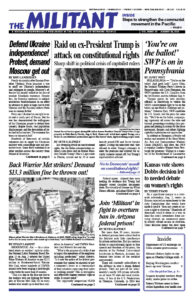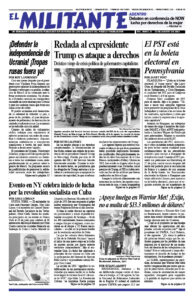Chinese warships and warplanes launched live-fire “exercises” surrounding Taiwan the day after an Aug. 2-3 visit to the island by House Speaker Nancy Pelosi, the highest-ranking U.S. official to visit there in 25 years. Beijing says the island is part of Chinese territory and Pelosi’s visit was a provocation.
The U.S. rulers are looking for ways to assert their domination of the Pacific, which they consider their “prize” for coming out on top in the imperialist slaughter of the Second World War. Central to their aims is curbing mounting competition from Beijing and the growing reach and capabilities of the Chinese military. To that end Washington helped initiate a defense pact last year establishing closer military collaboration and technology sharing with the rulers of Australia and the U.K.
Pelosi’s visit, part of a five-nation tour in East Asia, highlighted divisions within the Democratic Party and among the U.S. rulers. President Joseph Biden initially tried to head off the visit. Pelosi, also a Democrat, went anyway, backed by many Republicans.
In Taiwan’s capital, Taipei, Pelosi declared, “America stands with Taiwan.”
As a condition in establishing relations with Beijing, Washington adopted a “One China” policy in 1979, but continued giving the Taiwanese rulers political and military backing, provided they made no formal declaration of independence.
U.S. officials claim Chinese President Xi Jinping has advanced his timetable for reunification of Taiwan into China from later this decade to 18 months away.
The sharpening conflict between Washington and Beijing across Asia and the Pacific, including over Taiwan, adds to the growing instability of the imperialist world order already accelerated by Moscow’s invasion of Ukraine.
Beijing’s show of military force included imposing a four-day de facto blockade of the island, preventing sea and air transport in or over some of Taiwan’s territorial waters. Six live-fire zones encircled the island, targeting its two main commercial ports as well as several military bases.
The tensions threaten a wider conflict as the Taiwan Strait is a major sea route traversed by half the world’s container ships.
Five of Beijing’s missiles came down inside Japan’s exclusive economic zone that extends around some of its outlying islands. This was a warning to Tokyo, one of Washington’s main allies in the Pacific. U.S. forces are stationed on the southern Japanese island of Okinawa. The Japanese rulers are seeking to expand the size and use of their military.
Japan’s 50-year colonial rule of Taiwan was overturned in 1945. The island’s return to Chinese jurisdiction was widely welcomed by its people. In 1947 they rose in rebellion against the Kuomintang regime there that defended the class interests of the landlords and capitalists. The uprising was bloodily suppressed. After the victory of the 1949 Chinese Revolution, Kuomintang leader Chiang Kai-shek retreated to the island. A brutal U.S.-backed dictatorship was imposed for almost four decades.
Decades of rapid economic development created a weighty working class on the island of 23 million. While the big majority are ethnic Chinese, younger generations especially identify as Taiwanese. Many witnessed Beijing’s dismantling of political rights in nearby Hong Kong, and have no wish to come under its rule.

